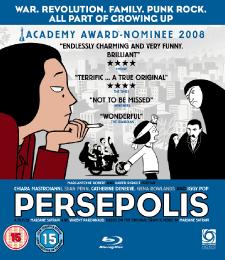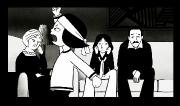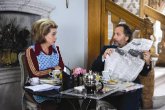Interview with Vincent Paronnaud
Do you remember your first meeting with Marjane Satrapi?
Six years ago she asked me to share her design studio. I had heard of Marjane, as she was beginning to get a name for herself. I was a bit wary at first, but I reluctantly accepted her offer.
Why?
I'm distrustful by nature! What's more, when she rang me up, although we had never met or talked, she sounded overly enthusiastic!
What had your career been like until then?
After dropping out of school at 17, I dabbled in quite a few things; drawing, music, etc… I began publishing graphic novels [under the penname Winshluss], writing serial storyboards and working on animated shorts.
When you read the Persepolis novels, what was your reaction?
Amazed. I was in the studio when Marjane was completing the second volume. In the beginning, I was afraid of her ethnic " Not Without My Daughter" style, and of the girly comic aspect, which, according to the media, characterized Marjane's work. It was in fact, just the opposite, I was swept off my feet. Her work has a strong, genuine power; the content is as valuable as the design, and it combines humour and emotion, which is quite rare.
Do you remember when she first asked you to make an animated feature based on the Persepolis books?
When Marc-Antoine Robert offered to produce Persepolis, she asked me to make the film with her. She was reassured because I had already directed black and white animated shorts. I couldn't refuse, I loved the book, and I loved Marjane. It was a wonderful opportunity for me to do something I had never done before, to work on such an artistically challenging project. It was both appealing and risky.
What sources did you draw upon when you started to think of the film?
We knew we had to keep the energy of the novels. We couldn't be content with filming one panel after another. In fact our sources were live-action films. I had seen a lot of Italian comedies because my mother loved them. Marjane is very fond of Murnau and German expressionism, so we drew our inspiration from that and then put together what we both liked. Marjane's book is about family life, so the film was going to be based on a central family theme also. The usual codes in animation didn't seem to fit, so I used movie-style editing, with a great many jump-cuts. Even from an aesthetic viewpoint, we drew our sources from cinematic techniques.
Did you watch films together before starting to work on Persepolis?
I did watch a few films like The Night Of The Hunter and Touch of Evil, and some action films like Duel which taught me a lot about editing. When films are well-made, whatever the genre, there are always things to learn.
More specifically, how did you manage to write the script together?
For three months, we met everyday for three to four hours. Neither of us can type, so we used a pencil because it can be erased. We'd read what had been written, crossing out, rewriting, cutting, etc… We had to strike the right balance between the crucial moments and the insignificant details of everyday life; it was hard to choose what had to be kept and what to leave out. After a while we forgot about the book and worked on the script.
Unlike the books, the film is a long flashback. How did you come up with the idea of the opening scene in colour?
Marjane had told me that one Friday (Friday is the day for flights to Tehran), she was feeling so low that she went to the airport with the intention of leaving. She spent the whole day there, crying and watching the planes taking off. We thought it would be a great opening scene. It conveys a sense of distance, of nostalgia for the story. It was all the more obvious as the film was about exile…
What do you think of her wish to deal with the story again, from a different artistic approach?
Apart from the artistic challenge, Marjane is leading a fight, so naturally she wanted to make it into a film. But she's a demanding person, with an honest intellectual purpose. It's rare to find autobiographical books like Persepolis, written with such modesty, and such little self-indulgence. She wants to make a statement, and hopes for people to get a different view from the one they watch on TV or read in the papers. Furthermore, she wants to address the meaning of exile, and what it means for a young girl to be thrown into the midst of historic events that she cannot comprehend…
Given the personal, autobiographical aspect of Persepolis, was it hard to find your place when you were writing the script?
It was not only hard, it was horrendous! Tinkering with somebody else's work is difficult but this was also somebody's life. Somebody sitting opposite me, somebody I know and love. I could see it was affecting Marjane, so I had to tread carefully, but she was extremely encouraging. The same for the visual aspect of the film; artistically speaking, she gave me free rein. We complemented each other, and there was always a moment when you needed the other's viewpoint or opinion.
What were your main concerns when you started making the film?
As Marjane's characters couldn't be anything but sheer black and white, we focused on the production design. As we couldn't have a black or white background we had to start from scratch. I used pictures of Tehran and Vienna to draw on reality, without being totally dependent on them, and integrated various grey shades. At the same time we had to bear in mind not to soften the graphic strength of Marjane's universe. We focused on fluent lines, talked a lot with Marc Jousset, and finally came up with a classic design.
As time went by, what was the most difficult hurdle to clear?
Keeping the enthusiasm going. Being under pressure for nearly three years, and trying to sustain our overall vision of the project was difficult. Marjane and I had a rather atypical approach to the codes, and even the work habits of animation. Marc-Antoine knew exactly what we wanted and he had been fighting hard on our behalf. So had Stéphane Roche who was in charge of the compositing*. Nothing was ever definitive. We were constantly changing things, testing new ideas, relentlessly improving what had been done. To keep things moving along, a lot of people helped us carry out our project because they understood our goal. The big plus was that everything was within reach at the one point where we worked all together in the studio. If I needed to change something I just went to the office next door and told the person in charge of the sequence. Even if it doesn't sound very original, I think human relationships are key when you make a film.
What surprised you most during the making of the film?
First and foremost, Marjane and I never had a row, despite there being a lot of stress. Marjane was under a great deal of strain. People didn't notice, because she's so enthusiastic and so full of passion and energy, whilst I'm a bit of a pain in the ass! Marjane has often told me that. Nothing is ever quite right for me. That's the way I am. What also surprised me was the way I became emotionally involved. I used to think I was rather detached from the subject matter of my work, but there was something so intrinsically emotional about this story. Marjane manages at once to convey these emotions and to remain modest. I wonder how she does it.
You're the one who suggested that Olivier Bernet write the score. Why did you pick him?
He understood what we wanted and was there, with us, from the very beginning. I even changed some images in accordance with his suggestions. In Persepolis, music plays a crucial role; it connects the sequences and gives unity to the film.
What particular memory will stay with you from the experience?
Perhaps the first screening of the rough cut. Marjane was sweating, and nearly passed out when she saw herself on screen. She tries hard to forget it's her life being told. It's better that she forgets, otherwise it would be unbearable, both for her and me.
Vincent Paronnaud a.k.a. Winshluss, was born in 1970 in La Rochelle. He is a major underground comic book artist.
Together with his friend and collaborator Cizo, he invented the character of "Monsieur Ferraille", the emblematic figure of the comic "Ferraille Illustré", which he co-edited with Cizo and Felder. His solo projects include Super Négra (1999), Welcome to the Death Club and Pat Boon - Happy End (2001).
He gained public recognition when he earned a nomination for Smart Monkey in 2004 and for Wizz and Buzz (with Cizo) in 2007 at the Angoulême Comic Book Festival. Winshluss and Cizo have also co-directed two shorts animations: O'BOY, WHAT NICE LEGS (B&W - 1 min - 2004) RAGING BLUES (B&W - 6 min - 2003). He co-directed PERSEPOLIS with Marjane Satrapi. It is his first feature length film.
Six years ago she asked me to share her design studio. I had heard of Marjane, as she was beginning to get a name for herself. I was a bit wary at first, but I reluctantly accepted her offer.
Why?
I'm distrustful by nature! What's more, when she rang me up, although we had never met or talked, she sounded overly enthusiastic!
What had your career been like until then?
After dropping out of school at 17, I dabbled in quite a few things; drawing, music, etc… I began publishing graphic novels [under the penname Winshluss], writing serial storyboards and working on animated shorts.
When you read the Persepolis novels, what was your reaction?
Amazed. I was in the studio when Marjane was completing the second volume. In the beginning, I was afraid of her ethnic " Not Without My Daughter" style, and of the girly comic aspect, which, according to the media, characterized Marjane's work. It was in fact, just the opposite, I was swept off my feet. Her work has a strong, genuine power; the content is as valuable as the design, and it combines humour and emotion, which is quite rare.
Do you remember when she first asked you to make an animated feature based on the Persepolis books?
When Marc-Antoine Robert offered to produce Persepolis, she asked me to make the film with her. She was reassured because I had already directed black and white animated shorts. I couldn't refuse, I loved the book, and I loved Marjane. It was a wonderful opportunity for me to do something I had never done before, to work on such an artistically challenging project. It was both appealing and risky.
What sources did you draw upon when you started to think of the film?
We knew we had to keep the energy of the novels. We couldn't be content with filming one panel after another. In fact our sources were live-action films. I had seen a lot of Italian comedies because my mother loved them. Marjane is very fond of Murnau and German expressionism, so we drew our inspiration from that and then put together what we both liked. Marjane's book is about family life, so the film was going to be based on a central family theme also. The usual codes in animation didn't seem to fit, so I used movie-style editing, with a great many jump-cuts. Even from an aesthetic viewpoint, we drew our sources from cinematic techniques.
Did you watch films together before starting to work on Persepolis?
I did watch a few films like The Night Of The Hunter and Touch of Evil, and some action films like Duel which taught me a lot about editing. When films are well-made, whatever the genre, there are always things to learn.
More specifically, how did you manage to write the script together?
For three months, we met everyday for three to four hours. Neither of us can type, so we used a pencil because it can be erased. We'd read what had been written, crossing out, rewriting, cutting, etc… We had to strike the right balance between the crucial moments and the insignificant details of everyday life; it was hard to choose what had to be kept and what to leave out. After a while we forgot about the book and worked on the script.
Unlike the books, the film is a long flashback. How did you come up with the idea of the opening scene in colour?
Marjane had told me that one Friday (Friday is the day for flights to Tehran), she was feeling so low that she went to the airport with the intention of leaving. She spent the whole day there, crying and watching the planes taking off. We thought it would be a great opening scene. It conveys a sense of distance, of nostalgia for the story. It was all the more obvious as the film was about exile…
What do you think of her wish to deal with the story again, from a different artistic approach?
Apart from the artistic challenge, Marjane is leading a fight, so naturally she wanted to make it into a film. But she's a demanding person, with an honest intellectual purpose. It's rare to find autobiographical books like Persepolis, written with such modesty, and such little self-indulgence. She wants to make a statement, and hopes for people to get a different view from the one they watch on TV or read in the papers. Furthermore, she wants to address the meaning of exile, and what it means for a young girl to be thrown into the midst of historic events that she cannot comprehend…
Given the personal, autobiographical aspect of Persepolis, was it hard to find your place when you were writing the script?
It was not only hard, it was horrendous! Tinkering with somebody else's work is difficult but this was also somebody's life. Somebody sitting opposite me, somebody I know and love. I could see it was affecting Marjane, so I had to tread carefully, but she was extremely encouraging. The same for the visual aspect of the film; artistically speaking, she gave me free rein. We complemented each other, and there was always a moment when you needed the other's viewpoint or opinion.
What were your main concerns when you started making the film?
As Marjane's characters couldn't be anything but sheer black and white, we focused on the production design. As we couldn't have a black or white background we had to start from scratch. I used pictures of Tehran and Vienna to draw on reality, without being totally dependent on them, and integrated various grey shades. At the same time we had to bear in mind not to soften the graphic strength of Marjane's universe. We focused on fluent lines, talked a lot with Marc Jousset, and finally came up with a classic design.
As time went by, what was the most difficult hurdle to clear?
Keeping the enthusiasm going. Being under pressure for nearly three years, and trying to sustain our overall vision of the project was difficult. Marjane and I had a rather atypical approach to the codes, and even the work habits of animation. Marc-Antoine knew exactly what we wanted and he had been fighting hard on our behalf. So had Stéphane Roche who was in charge of the compositing*. Nothing was ever definitive. We were constantly changing things, testing new ideas, relentlessly improving what had been done. To keep things moving along, a lot of people helped us carry out our project because they understood our goal. The big plus was that everything was within reach at the one point where we worked all together in the studio. If I needed to change something I just went to the office next door and told the person in charge of the sequence. Even if it doesn't sound very original, I think human relationships are key when you make a film.
What surprised you most during the making of the film?
First and foremost, Marjane and I never had a row, despite there being a lot of stress. Marjane was under a great deal of strain. People didn't notice, because she's so enthusiastic and so full of passion and energy, whilst I'm a bit of a pain in the ass! Marjane has often told me that. Nothing is ever quite right for me. That's the way I am. What also surprised me was the way I became emotionally involved. I used to think I was rather detached from the subject matter of my work, but there was something so intrinsically emotional about this story. Marjane manages at once to convey these emotions and to remain modest. I wonder how she does it.
You're the one who suggested that Olivier Bernet write the score. Why did you pick him?
He understood what we wanted and was there, with us, from the very beginning. I even changed some images in accordance with his suggestions. In Persepolis, music plays a crucial role; it connects the sequences and gives unity to the film.
What particular memory will stay with you from the experience?
Perhaps the first screening of the rough cut. Marjane was sweating, and nearly passed out when she saw herself on screen. She tries hard to forget it's her life being told. It's better that she forgets, otherwise it would be unbearable, both for her and me.
Vincent Paronnaud a.k.a. Winshluss, was born in 1970 in La Rochelle. He is a major underground comic book artist.
Together with his friend and collaborator Cizo, he invented the character of "Monsieur Ferraille", the emblematic figure of the comic "Ferraille Illustré", which he co-edited with Cizo and Felder. His solo projects include Super Négra (1999), Welcome to the Death Club and Pat Boon - Happy End (2001).
He gained public recognition when he earned a nomination for Smart Monkey in 2004 and for Wizz and Buzz (with Cizo) in 2007 at the Angoulême Comic Book Festival. Winshluss and Cizo have also co-directed two shorts animations: O'BOY, WHAT NICE LEGS (B&W - 1 min - 2004) RAGING BLUES (B&W - 6 min - 2003). He co-directed PERSEPOLIS with Marjane Satrapi. It is his first feature length film.
















































Your Opinions and Comments
Be the first to post a comment!